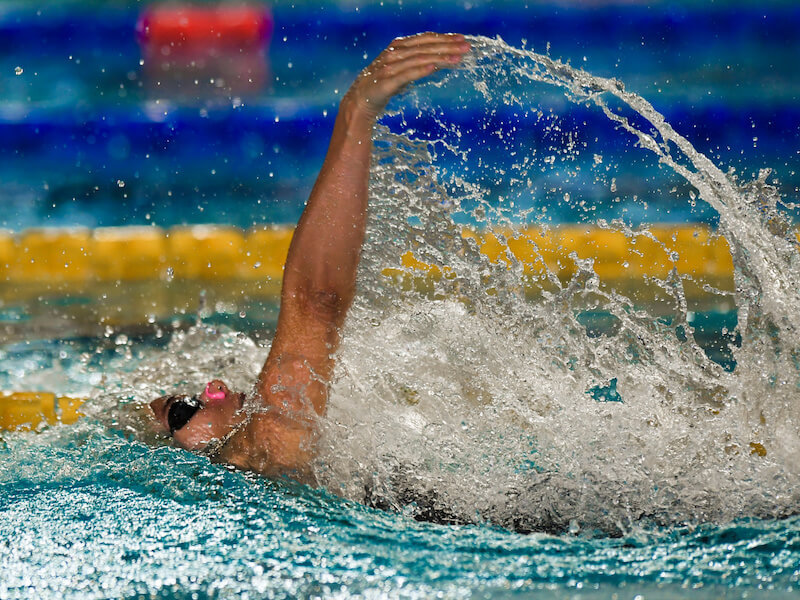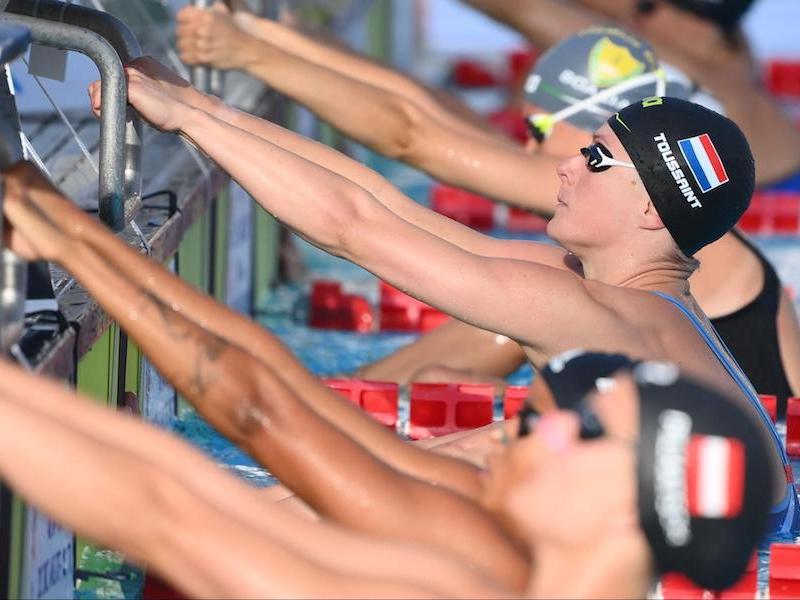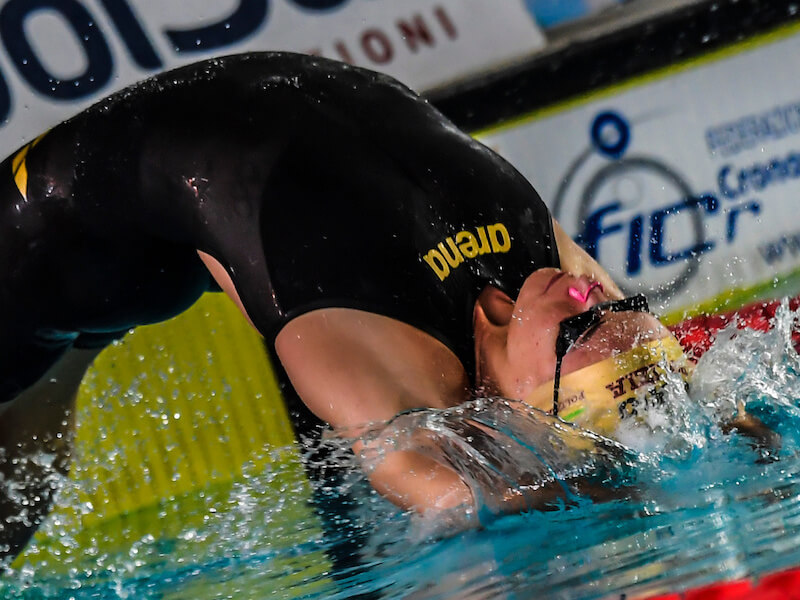Backstroke Start Technique: A Beginner’s Guide
There’s not much point learning how to swim a good backstroke without first nailing your backstroke start technique. The start is one of the most important moments in competitive swimming, as it’s when your entire body is at its most propulsive.
After reading this article, you should feel confident about your backstroke start technique. We’ll summarize both the starting position and movement. You’ll then learn three tips that could give your backstroke swimming the edge.
Get to Grips With Your Backstroke Start Technique

The backstroke may not be the most physically demanding of strokes, but it does stand out in a league of its own. It is the only Olympic stroke where you swim on your back, and it mainly involves your back muscles, rather than your chest muscles.
Unlike downward-facing strokes, you can’t just “follow” the black line on the bottom of the pool, so your swimming technique has to be as streamlined as possible. Since you are facing away from the surface of the water, it is hardly surprising that the backstroke start technique differs from other strokes. Come join us for an inside look on how to achieve a solid backstroke start.
Starting position
A bad start can put you in the wake of other swimmers, leaving you feeling defeated in the earliest stage of a race. A good start matters in any stroke, but let’s find out how to start out strong with the right body position for a serious backstroke start.
Because you swim on your back, your backstroke starts by facing the wall with your back toward the pool. For a backstroke start technique that can take you through to the championships, you should:
- Take a firm grip of the bar below the starting block.
- Place your feet, either below or above the water level, against the wall, more or less shoulder-width apart. If your pool has a backstroke wedge, there will be less chance of your feet slipping.
- Get ready to push off by pulling yourself gently toward the starting block until your buttocks reach the water line.
- Relax your neck and lower your head position so that you are looking at your knees.
Starting movement
When you hear the start command, your arms should swing around sideways in a low semi-circular arc. Your knees should extend and your legs should push in the opposite direction, so that your body comes above the surface of the water as you throw your head backward.
When you re-enter the water, your hands should be joined one on top of the other above your head. Your back should arch even further, and your legs, which will now be in a rather extended position, should guide your body. Your hands should enter the water before the rest of your body, which must remain as straight as possible to reduce drag to a minimum. More streamline equals less drag!
Once you have entered the water, exploit the underwater phase until (you feel) you are traveling as fast as your leg kick.
During the underwater phase, you can use either an ordinary backstroke kick (alternate legs) or a dolphin kick lying on your back until you reach the 15-meter limit after the start.
When your underwater speed is the same as your swim speed, in regard to your leg kick, then it is the right moment to break out from the water and start swimming on the surface of the water.
During practice, consider using backstroke drills to make your training more enjoyable and beneficial.
Fine-Tuning Your Backstroke Start Technique

You’ve now got a good idea of how a backstroke start should be performed. If you’re still unsure, we recommend watching a video or speaking to your coach. Watching people’s start techniques in slow motion can really help drill the concepts into your mind.
Once you’ve got the basics down, check out these tips to help balance out all the little intricacies of the stroke until you are left with a flawless backstroke start.
Fix Your Feet
From freestyle to breaststroke, every stroke has its fair share of things that you can slip up on. In backstroke, a lot of people literally slip up right on the wall just as the race has begun. Thanks to the high degree of explosive movement as you arch your back and fly into the water, it is easy to accidentally slip your feet along the wall. This is a huge problem, as not only is your trajectory set of course slightly, you are also losing a lot of that initial propulsive force.
There’s a simple way to overcome this, and it’s half physical, half psychological. Plant your feet solidly against the wall, twisting them until they feel planted. It’s the same technique a powerlifter uses to safely take on heavy squats. If you feel planted before your start, you’ll feel more confident and will be prepared for a solid start.
Rise Above
The deeper you enter on your breaststroke start, the more you’ll have to dolphin kick your way to the surface. Underwater dolphin kicks are powerful, but they use a lot of muscle power and energy. This means you don’t want to be underwater for any longer than you need to.
So, how do you achieve a clean entry that doesn’t get you in too deep? The main thing that dictates your angle of entry is that big heavy thing on your shoulders: your head.
The essential takeaway is that by the time your hands touch the surface of the water, your head needs to be in a streamlined position with the rest of your upper body.
You can have your head in alignment from the moment the start gun goes off. Or you can jerk your head back quickly at the start, realigning as you enter the water.
Whichever technique you chose, it’s the streamline entry that really counts.
Prevent Drag
Any competitive swimmer’s worst enemy is drag. Half of what you learn in the pool is how to prevent drag, and it’s just as important when it comes to swimming starts.
The backstroke start is such an impressive-looking start because so much of it is spent in the air before even entering the water. This blink-of-an-eye spent in the air gives you the opportunity to get a clean entry, which can shave off some seconds.
As you push off the block, snap your hips upward away from the water. This will stop them from sinking into the water, slowing you down. As your body then enters the water, you must throw your toes up in the air as well.
Practice Makes Perfect

So, you now have some insight into how to have the starting position and movement of a world champion. You know the importance of locking in your feet, using your head to get a clean entry and avoiding drag.
But when you combine all this information together, it can get a little overwhelming. The great thing is though, the backstroke start (alongside the flip turn) is a very tiny portion of your overall backstroke technique. Since it obviously starts against the wall of the pool, it is very easy to repeat over and over again. If you want to improve your confidence and technique, you can spend your entire workout just practicing your backstroke start technique without even swimming a length.
If you’re in need of swimming gear and accessories for training or competition, be sure to check out arena’s line of swimwear and equipment.
Written by:
arena coaches
Swim coaches, trainers and experts will give you all kinds of tips for performing at your best in both training and races.







